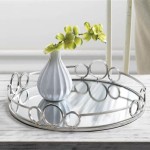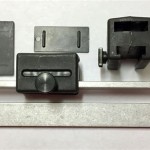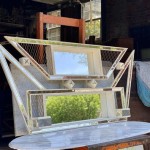The Enduring Appeal of Large Mid-Century Modern Mirrors
Mid-Century Modern design, an aesthetic movement characterized by clean lines, organic shapes, and an optimistic embrace of new materials and technologies, continues to captivate homeowners and designers alike. Within this iconic style, the large mirror stands out as a particularly impactful element, capable of transforming spaces and reflecting the design principles of the era. Understanding the specific characteristics, benefits, and sourcing considerations of large Mid-Century Modern mirrors is crucial for anyone looking to integrate this timeless piece into their interior design.
The Mid-Century Modern period, roughly spanning from the 1930s to the 1960s, witnessed a shift in design philosophy. Post-World War II, there was a desire for homes that were both functional and aesthetically pleasing, reflecting the burgeoning prosperity and a forward-looking spirit. This movement rejected the ornate styles of previous decades in favor of simplicity, natural materials, and a connection to the outdoors. Furniture and décor were designed to be accessible and adaptable to smaller, more modern homes.
Large mirrors, in particular, gained prominence as tools to enhance the perceived size of living spaces and to amplify natural light. They were used not just as functional objects for grooming but as strategic design elements to create a sense of openness and visual interest. This article will explore the defining characteristics of these mirrors, the advantages they offer, and how to find authentic or high-quality reproductions today.
Defining Characteristics of Large Mid-Century Modern Mirrors
Several key features distinguish large Mid-Century Modern mirrors from those of other eras. These characteristics are rooted in the design principles of the time and contribute to the overall aesthetic appeal of the style.
Firstly, the frames are typically minimalist and understated. Elaborate carvings and heavy ornamentation were largely discarded in favor of clean lines and simple geometric shapes. Frames were frequently crafted from natural materials like wood, particularly teak, walnut, and oak, which were popular choices for their warm tones and natural grain patterns. Metal frames, often in brushed brass or chrome, were also common, providing a sleek and modern contrast to the wood tones prevalent in other design elements. The objective was to create a frame that complemented the mirror itself without overshadowing it.
Secondly, shape played a significant role in the design of these mirrors. While rectangular and square mirrors were certainly popular, the Mid-Century Modern era also embraced organic and asymmetrical shapes. Oval mirrors, freeform mirrors with rounded edges, and even starburst-shaped mirrors were used to add visual interest and a touch of whimsy to spaces. These unconventional shapes helped to soften the often-angular lines of Mid-Century Modern furniture and architecture, creating a more balanced and inviting environment. Size was also crucial; large mirrors were deliberately chosen to maximize their impact on the room's spatial perception.
Thirdly, details, although minimal, were carefully considered. Beveled edges on the glass were a common feature, adding a touch of sophistication and depth. Sometimes, the frame would incorporate small decorative accents, such as inlaid wood details or subtle metal embellishments. However, the emphasis remained on simplicity and functionality. Any decorative elements were intended to enhance the overall design without detracting from the clean, uncluttered aesthetic.
Finally, mounting and display were important considerations. Large Mid-Century Modern mirrors were often hung directly on the wall, allowing them to blend seamlessly into the surrounding architecture. Others were designed as leaner mirrors, providing a casual and elegant way to add height and depth to a room. The positioning of the mirror was carefully considered to maximize its impact on natural light and to create visually interesting reflections of other design elements in the space.
The Practical and Aesthetic Advantages of Large Mirrors
Beyond their stylistic appeal, large Mid-Century Modern mirrors offer several practical and aesthetic advantages that make them a valuable addition to any home. These benefits contribute to both the functionality and the visual appeal of a space.
One of the most significant advantages is their ability to visually expand a room. By reflecting light and creating the illusion of greater depth, large mirrors can make even small spaces feel significantly larger and more open. This is particularly beneficial in apartments or homes with limited square footage, where maximizing the perceived space is crucial. The strategic placement of a large mirror can transform a cramped room into a more inviting and airy environment.
Another key benefit is their ability to amplify natural light. By reflecting sunlight from windows, large mirrors can brighten up dark corners and reduce the need for artificial lighting during the day. This not only enhances the overall ambiance of the room but can also contribute to energy savings. The reflection of natural light can also have a positive impact on mood and well-being, creating a more cheerful and inviting atmosphere.
Furthermore, large mirrors serve as striking focal points in a room. Their reflective surface draws the eye and creates a sense of drama and visual interest. When strategically placed, they can highlight architectural details, reflect artwork, or create stunning perspectives. A well-chosen large mirror can elevate the overall design of a room and add a touch of sophistication and elegance.
Finally, large mirrors can be used to enhance the symmetry and balance within a room. By placing a mirror opposite a significant piece of furniture or architectural feature, one can create a sense of visual harmony and equilibrium. This can be particularly effective in creating a more organized and aesthetically pleasing space. The thoughtful use of mirrors can contribute to a feeling of calmness and order within the home.
Sourcing and Integrating Large Mid-Century Modern Mirrors
Finding authentic or high-quality reproduction large Mid-Century Modern mirrors requires careful research and consideration. The marketplace offers a range of options, from vintage pieces to contemporary interpretations, and understanding the nuances of each is crucial for making an informed decision.
For those seeking authentic vintage mirrors, antique stores, estate sales, and online marketplaces specializing in vintage furniture are the primary sources. When evaluating a vintage piece, it is essential to carefully examine the condition of both the glass and the frame. Look for signs of age and wear, but also be wary of excessive damage that could compromise the structural integrity or aesthetic appeal of the mirror. Pay close attention to the quality of the frame construction and the authenticity of the materials used. Researching the maker or designer, if known, can also help to verify the authenticity and value of the piece.
If sourcing a vintage piece proves challenging, high-quality reproductions offer a viable alternative. Many contemporary furniture manufacturers and retailers offer mirrors that are designed to emulate the aesthetic of the Mid-Century Modern era. When choosing a reproduction, prioritize quality materials and craftsmanship. Look for frames made from solid wood or durable metal, and ensure that the glass is of a high grade with a clear and distortion-free reflection. Pay attention to the details, such as the finish of the frame and the presence of beveled edges, which can contribute to the overall authenticity of the design.
Integrating a large Mid-Century Modern mirror into a space requires careful consideration of its size, shape, and placement. Before purchasing a mirror, measure the available wall space and consider the overall dimensions of the room. Choose a mirror that is appropriately sized for the space, ensuring that it does not overwhelm the room or appear too small. Consider the shape of the mirror in relation to the other design elements in the room, and choose a shape that complements the existing furniture and architecture.
Finally, consider the placement of the mirror in relation to natural light sources and other focal points in the room. Position the mirror to maximize the reflection of natural light and to create visually interesting reflections of other design elements. Avoid placing the mirror in direct sunlight, as this can cause glare and potentially damage the glass. Experiment with different placements to find the optimal location that enhances the overall ambiance and visual appeal of the space. Securing the mirror safely and properly is also essential, especially with larger pieces. Professional installation might be necessary to ensure safety and stability.

Mid Century Modern Mirror Geometric Wall Large Wooden

Large Mid Century Modern Walnut Floor Mirror Vintage Home Boutique

Stunning Mid Century Modern Mirror Sunburst Wall Starburst Handmade Solid Brass Large 120cms High X 80cms Wide

Large Round Wall Mirror In Mid Century Modern Entryway Décoration Intérieure Mobilier De Salon Interieur Design

Large Brutalist Mid Century Modern Wall Mirror

Mid Century Modern Wood Framed Mirror Vanity Bathroom Decorative Large 4 Sizes 20 Colors Dark Walnut

Large Mid Century Italian Bamboo And Cane Wall Mirror From Vera Dal 1960s For At Pamono

Large Mid Century Modern Walnut Framed Wall Mirror At 1stdibs

Mid Century Modern Large Mirror Chairish

Pair Of Large Mid Century Modern Walnut Mirrors For At 1stdibs Mirror Full Length








